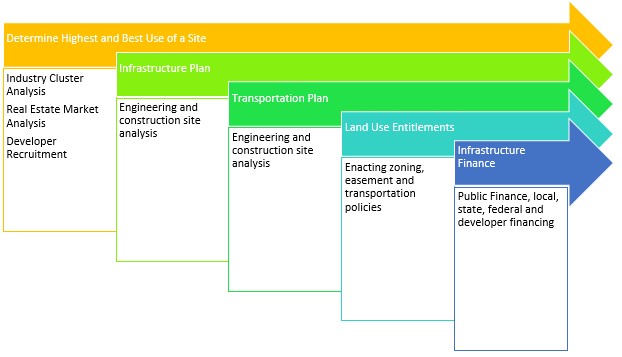Site Development Strategy Key to Early Opportunity Zone Success
Nate Green
Montrose Development Advisors
Marketing helps but a fancy web site cannot replace a strong site development plan that illustrates an Opportunity Zone is prepared for development. Creating an Opportunity Zone site development plan involves five steps that includes the creation of site plans and infrastructure finance strategies, enacting land use entitlements and tax incentives, advocating for a state and local Opportunity Zone public policy agenda, marketing the Opportunity Zone and seeking professional guidance to operate an Opportunity Zone by seeking investors. 
Site plan and infrastructure finance strategies are an essential first step for Opportunity Zone development as all these 8700 census tracts are competing for investors from around the U.S.. Early Opportunity Zone investment is likely to travel to Opportunity Zones with strong site development plans that outline target industries and infrastructure finance strategies. Investors want to understand the likelihood of a complicated site generating a profit. This profit is tied to the succeed gaining in value. The value proposition is most likely connected to attracting an end-user with an interest in the site but that end user will not move to an Opportunity Zone unless the infrastructure, zoning, water and sewer agreements and local and state tax incentives are in place.
Opportunity Zones must be focused on the highest and best use of the site. Different Opportunity Zones will have different highest and best uses. Research into the industry likely to find an Opportunity Zone site attractive should be based upon an industry cluster analysis that develops a location quotient measure based upon federal government occupational data as well as with an eye on the impact of automation and other economic trends that could impact the future of investment at the site. In addition, the costs and availability as measured by the real estate market matter for site development plans as rental rates, land purchase, construction costs, vacancy and absorption rates all impact the likelihood of economic success at an Opportunity Zone.
Understanding the transportation and water and sewer and other infrastructure costs at a site is essential to launching an Opportunity Zone. No site can develop without adequate infrastructure to permit transportation to and within the site as well as the provision of water and sewer service at the site. Both Brownfield and Greenfield sites need this analysis so investors can understand the complete development costs tied to their Opportunity Zone investment.
Finally, learning the costs of infrastructure at an Opportunity Zone site sets up the discussion for how these costs are going to be met. Opportunity Zone infrastructure finance strategies can be based upon U.S. Commerce Department Economic Development Administration Public Infrastructure Grants, New Market Tax Credits, historic preservation redevelopment tools such as Downtown Redevelopment Districts and Historic Preservation Tax Credits, state economic development organization loans and grants, local public finance programs such as Tax Increment Financing and finally local and state tax credits and abatements.
Opportunity Zone site development strategies are not flashy or exciting but they involve the hard work essential for Opportunity Zones to gain early investment.
Record Attendance as 600 Economic Development Leaders Gather in Akron for the 2025 OEDA Summit
For Immediate Release Record Attendance as 600 Economic Development Leaders Gather in Akron for the 2025 OEDA Summit Nation's largest state-level economic development conference marks 45 years of advancing Ohio's growth and collaboration. AKRON, OHIO – Thursday,...
OEDA Board Adopts Policy Platform, Affirms ED for All, Works on Strategic Plan
For Immediate Release OEDA Board participates in strategic planning led by Camoin Associates. Comprehensive platform replaces 2016 Agenda for Ohio, first strategic plan since 2015 AKRON, OHIO – TUESDAY, October 14, 2025 – The Ohio Economic Development Association...
OEDA Quarterly Report – Q2 2025
April 1 – June 30, 2025 From Expansion to Execution: OEDA’s Q2 2025 in Review OEDA’s second quarter was marked by continued momentum across our strategic pillars—membership, programming, partnerships, and advocacy. With a growing and increasingly engaged network, a...